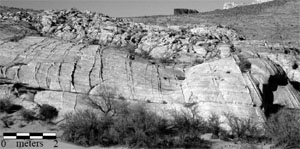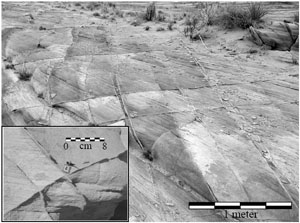| |||||||
|
|
|||||||
|
|
|||||||
| Compaction Band Patterns | |||||||
|
Both shear and compaction bands occur extensively within Entrada Sandstone cropping out in the San Rafael Desert, Utah, and Aztec Sandstone cropping out in Valley of Fire State Park, Nevada. Individual bands within the sets of bands commonly are spaced anywhere from centimeters to meters apart (Figures 1(a) and (b)). It is not uncommon, however, to observe neighboring bands with anastomosing or inosculating patterns with trends and dips varying by 25 degrees or more over the scale of centimeters to meters (Aydin, 1978; Aydin and Johnson, 1983).
When two distinct sets of either shear or compaction bands overprint, they form a crosshatch pattern (Figures 2(a) and (b)) with varying degrees of intersection angles (Aydin and Reches, 1982). Individual sets within crosshatch patterns have spacing ranging from a few centimeters to a few meters with both sets typically exhibiting comparable spacing. Here the nature of the intersections is intriguing. The younger bands generally cross-cut the older ones. This cross-cutting is obvious for shear bands but assigning age relationships to the intersecting compaction bands is not straight forward. There are also cases that one band near the intersection turns sharply and becomes parallel to the band belonging to the other set without intersecting it. Both types of geometries may occur at the same location as shown in Figure 3. | |||||||
| Reference: |
|||||||
| Sternlof, K.R., 2006 |
|||||||
|
Readme | About Us | Acknowledgement | Terms of Use | Ⓒ Rock Fracture Knowledgebase 2017 |
|||||||


